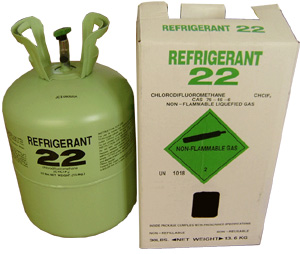This
year, 2013, is the first year that there will not be enough R-22 refrigerant
produced to meet residential demand. You and I both know that when supply
tightens up prices rise. Freon is already expensive. So plan on prices rising
this summer and over the coming years.
 |
| Ozone-depleting R-22 Refrigerant |
But terms like R-22 are a little technical, let
me explain; R-22 has been the refrigerant of choice for residential heat pump
and air-conditioning systems for more than four decades. Unfortunately for the
environment, R-22 contributes to ozone depletion. In addition, R-22 is a
greenhouse gas that contributes significantly to global warming.
What is being done to keep us cool?
As R-22 is phased out over the coming years
manufacturers of residential air conditioning systems are offering equipment
that uses ozone-friendly refrigerants. Many homeowners may be misinformed about
how much longer R-22 will be available to service their central A/C systems and
heat pumps. Homeowners need information about the transition when deciding
whether to purchase a new A/C system or heat pump, or when having an existing
system repaired.
Existing units using R-22 can continue to be serviced with R-22. There is no EPA requirement for homeowners to change or convert R-22 units for use with a non-ozone-depleting substitute refrigerant.
New refrigerants have been developed and many companies are using them to replace R-22 in existing systems. Such changes, called "retrofits," are allowed if the alternative has been found acceptable for that type of use.
Existing units using R-22 can continue to be serviced with R-22. There is no EPA requirement for homeowners to change or convert R-22 units for use with a non-ozone-depleting substitute refrigerant.
New refrigerants have been developed and many companies are using them to replace R-22 in existing systems. Such changes, called "retrofits," are allowed if the alternative has been found acceptable for that type of use.
WARNING: Use a reputable Air Conditioning
contractor
One important thing a
homeowner can do for the environment, regardless of the refrigerant used, is to
select a reputable dealer that employs service
technicians who are EPA-certified to handle refrigerants.
Technicians often call this certification "Section 608
certification," referring to the part of the Clean Air Act that requires
minimizing releases of ozone-depleting chemicals from HVAC equipment.
A Reputable Air Conditioning Contractor will take the time to learn and train their service technicians how to properly retrofit an air conditioning system with ozone friendly refrigerant.
There are steps that need to be taken and a specific way these retrofits need to be handled so extra training is required to be able to properly provide new safer refrigerant.
A Reputable Air Conditioning Contractor will take the time to learn and train their service technicians how to properly retrofit an air conditioning system with ozone friendly refrigerant.
There are steps that need to be taken and a specific way these retrofits need to be handled so extra training is required to be able to properly provide new safer refrigerant.
If your home or business is located in
the DFW area Supreme Air Service technicians are all trained in the replacement of R-22 and they
can be reached by calling (214) 310-1680.
Have a great day!

